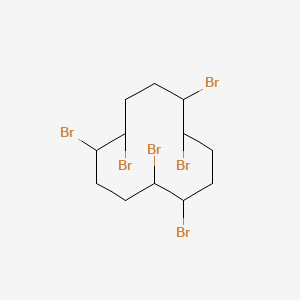D0586 | 1,2,5,6,9,10-hexabromocyclododecane
| Toxicity | Dose | Time | Species | Model | Method | Action | Positive criterion | Reference |
|---|---|---|---|---|---|---|---|---|
| MEMBRANE POTENTIAL | 6.93±1.95 | human | qHTS-HepG2 | MMP assay | decrease | IC50 | 163 | |
| MEMBRANE POTENTIAL | 6.31 | human | HepG2 | MMP assay | decrease | IC50 | 163 | |
| MEMBRANE POTENTIAL | 32.03±16.51 | rat | hepatocytes | MMP assay | decrease | IC50 | 163 | |
| Pictogram | Signal | Statements | Precautionary Statement Codes |
|---|---|---|---|
   |
Warning |
Aggregated GHS information provided by 342 companies from 16 notifications to the ECHA C&L Inventory. Each notification may be associated with multiple companies. Reported as not meeting GHS hazard criteria by 3 of 342 companies. For more detailed information, please visit ECHA C&L website Of the 15 notification(s) provided by 339 of 342 companies with hazard statement code(s): H315 (17.7%): Causes skin irritation [Warning Skin corrosion/irritation] H319 (17.7%): Causes serious eye irritation [Warning Serious eye damage/eye irritation] H335 (17.7%): May cause respiratory irritation [Warning Specific target organ toxicity, single exposure Respiratory tract irritation] H361 (53.98%): Suspected of damaging fertility or the unborn child [Warning Reproductive toxicity] H362 (53.98%): May cause harm to breast-fed children [Reproductive toxicity, effects on or via lactation] H400 (66.67%): Very toxic to aquatic life [Warning Hazardous to the aquatic environment, acute hazard] H410 (82.3%): Very toxic to aquatic life with long lasting effects [Warning Hazardous to the aquatic environment, long-term hazard] Information may vary between notifications depending on impurities, additives, and other factors. The percentage value in parenthesis indicates the notified classification ratio from companies that provide hazard codes. Only hazard codes with percentage values above 10% are shown. |
P201, P202, P260, P261, P263, P264, P270, P271, P273, P280, P281, P302+P352, P304+P340, P305+P351+P338, P308+P313, P312, P321, P332+P313, P337+P313, P362, P391, P403+P233, P405, and P501; (The corresponding statement to each P-code can be found at the GHS Classification page.) |
  |
Warning |
H361: Suspected of damaging fertility or the unborn child [Warning Reproductive toxicity] H362: May cause harm to breast-fed children [Reproductive toxicity, effects on or via lactation] H410: Very toxic to aquatic life with long lasting effects [Warning Hazardous to the aquatic environment, long-term hazard] |
P201, P202, P260, P263, P264, P270, P273, P281, P308+P313, P391, P405, and P501; (The corresponding statement to each P-code can be found at the GHS Classification page.) |
 |
Warning |
H400: Very toxic to aquatic life [Warning Hazardous to the aquatic environment, acute hazard] H410: Very toxic to aquatic life with long lasting effects [Warning Hazardous to the aquatic environment, long-term hazard] |
P273, P391, and P501; (The corresponding statement to each P-code can be found at the GHS Classification page.) |
| 1,2,5,6,9,10-HEXABROMOCYCLODODECANE | 1,2,5,6,9,10-Hexabromocyclodecane | 1,2,5,6,9,10-Hexabromocyclododecan |
| 1,2,5,6,9,10-Hexabromocyclododecane (HBCD) | 1,2,5,6,9,10-Hexabromocyclododecane, 95% | 1,2,5,6,9,10-Hexabromocyclododecane, analytical standard; |
| 3194-55-6 | ACMC-1BN89 | AK116613 |
| AKOS015836044 | ANW-27232 | AX8052905 |
| CAS-3194-55-6 | CD-75 | CHEBI:134063 |
| CHEMBL375298 | CTK3J1623 | Cyclododecane, 1,2,5,6,9,10-hexabromo- |
| DB-068553 | DEIGXXQKDWULML-UHFFFAOYSA-N | DSSTox_CID_7527 |
| DSSTox_GSID_27527 | DSSTox_RID_78489 | DTXSID4027527 |
| EINECS 221-695-9 | FT-0626944 | HBCD |
| HSDB 6110 | KS-0000010E | KSC491M2H |
| LS-55963 | NCGC00164063-01 | NCGC00164063-02 |
| NCGC00257050-01 | NCGC00258953-01 | Q420301 |
| RTR-036468 | SC-18694 | SCHEMBL25669 |
| ST2414740 | Saytex HBCD-LM | TR-036468 |
| Tox21_201402 | Tox21_303176 | W-106868 |

